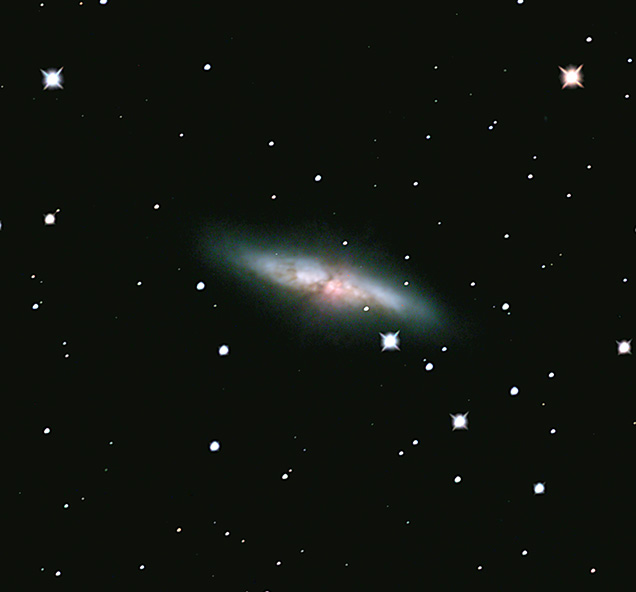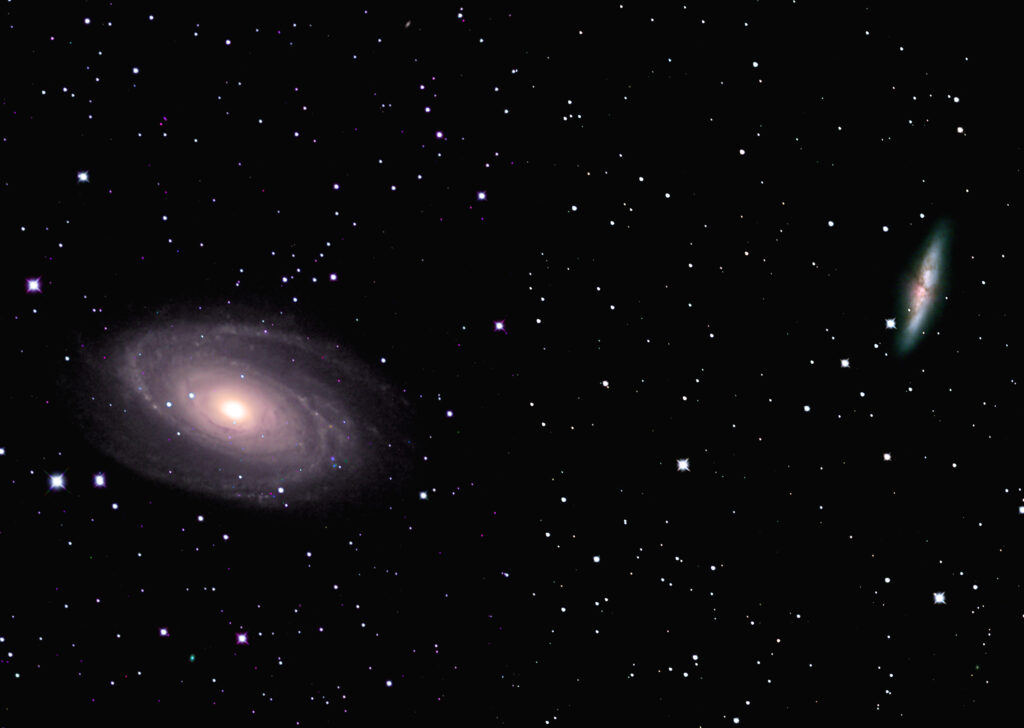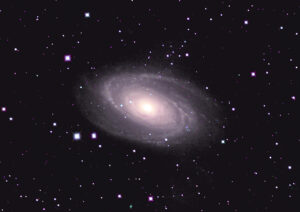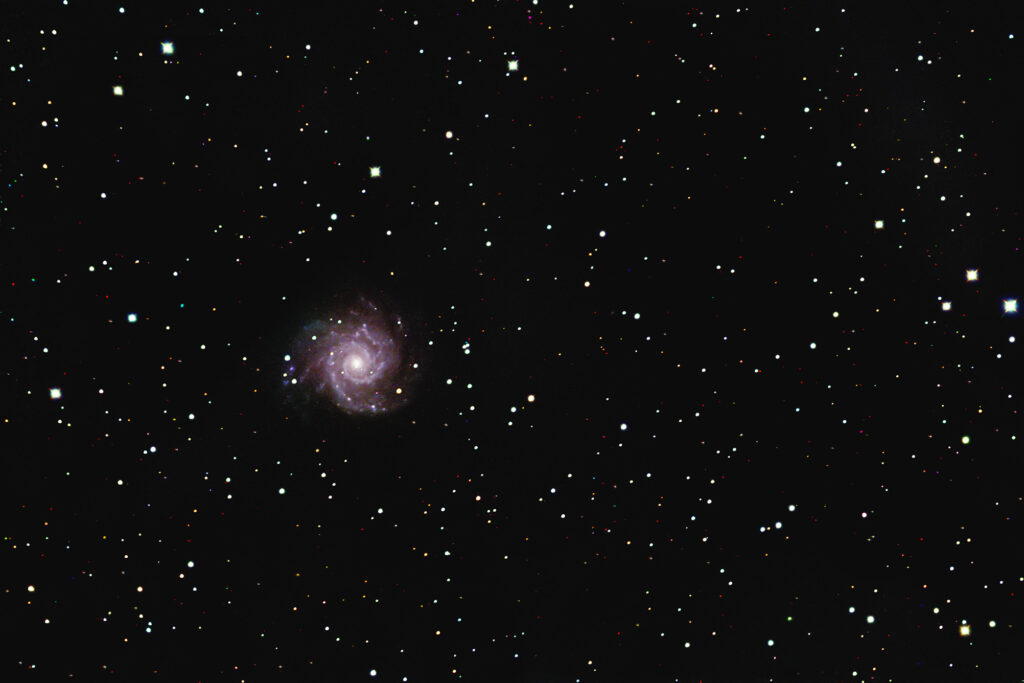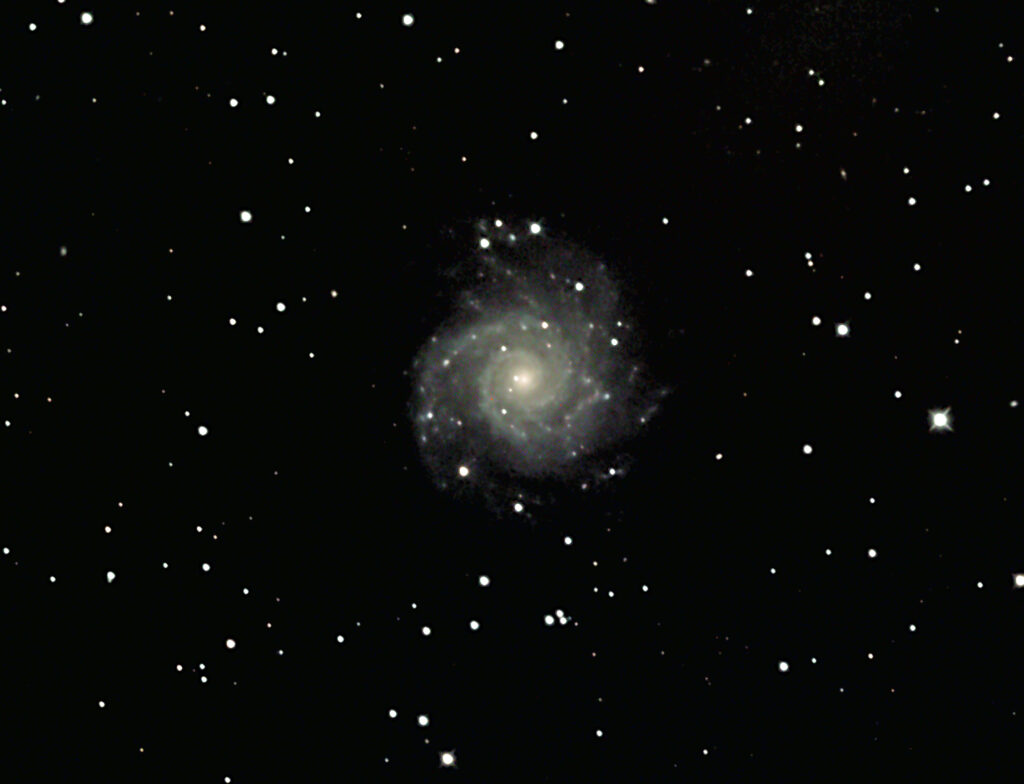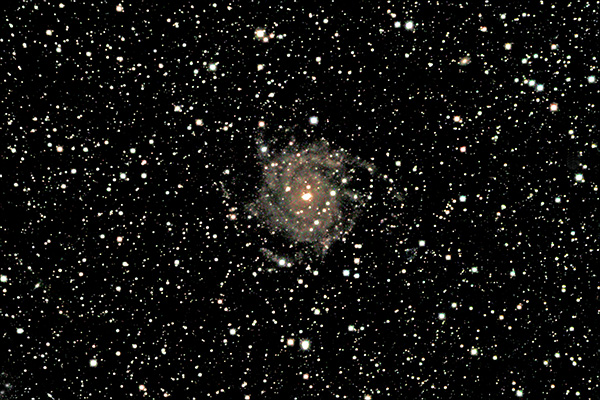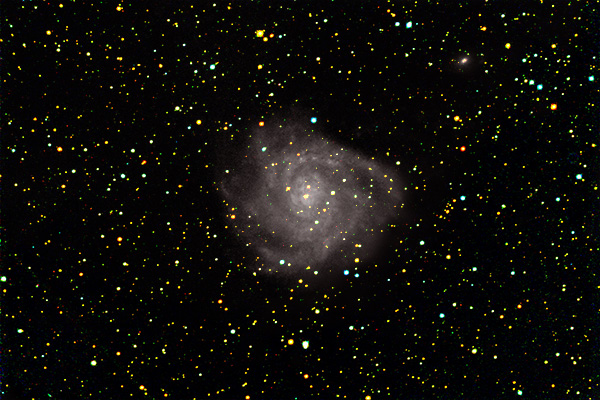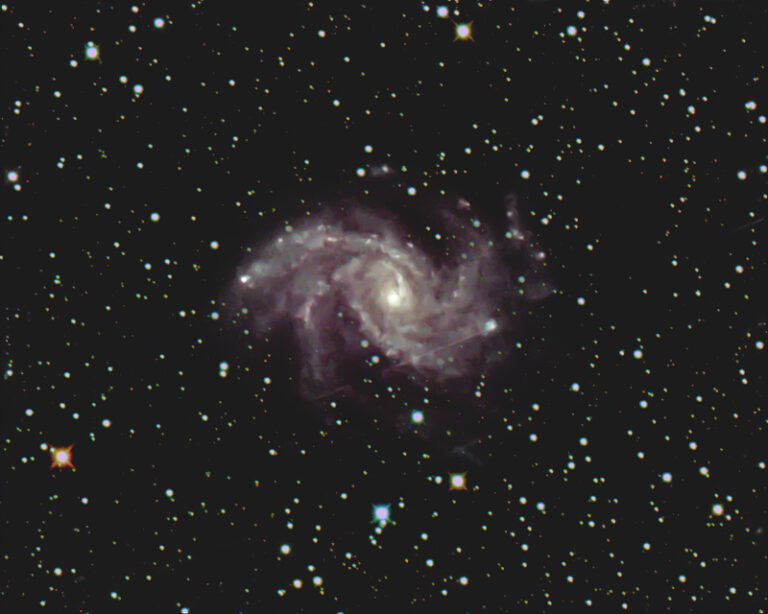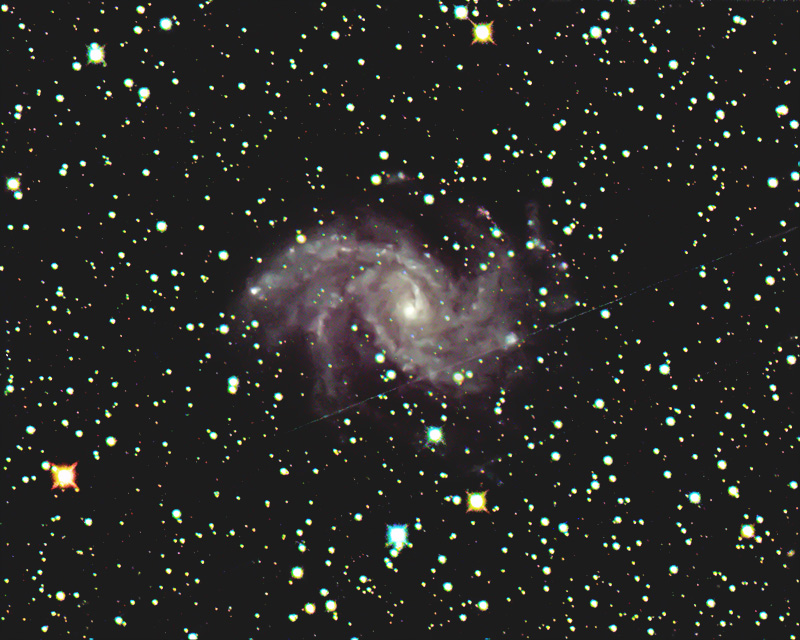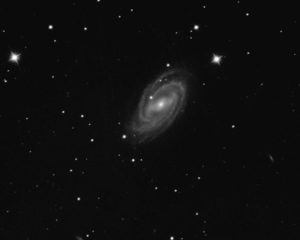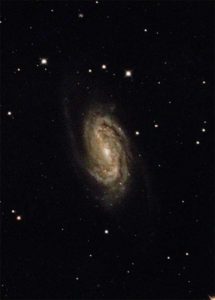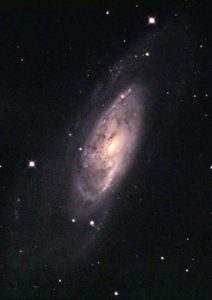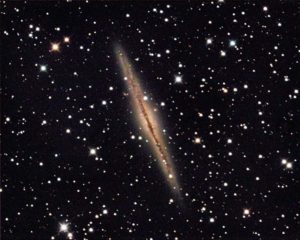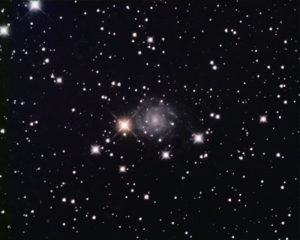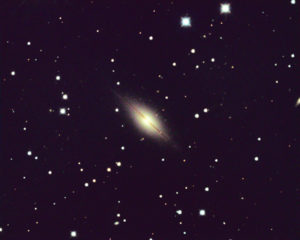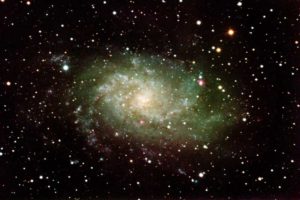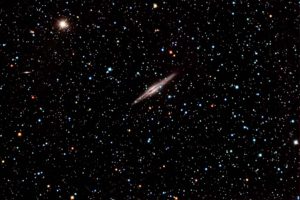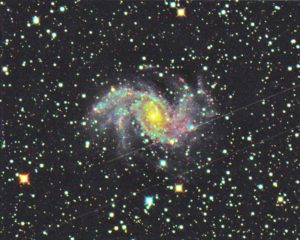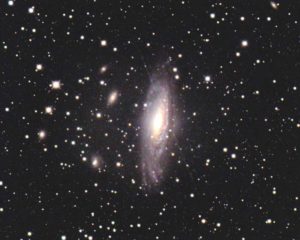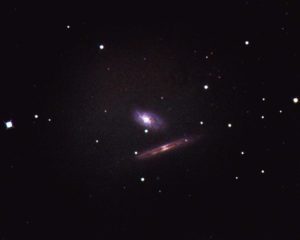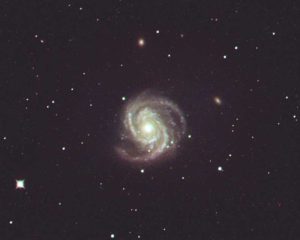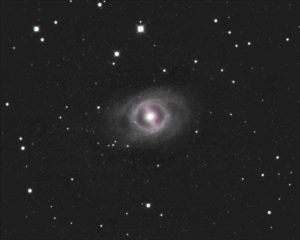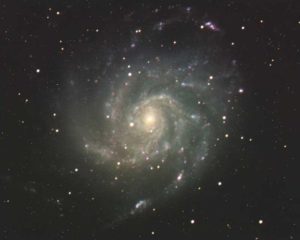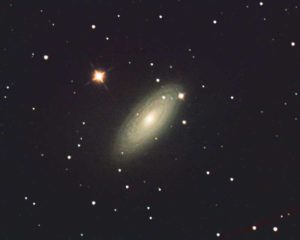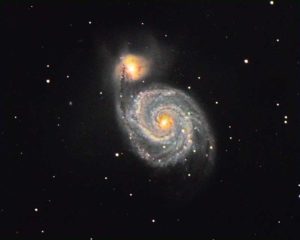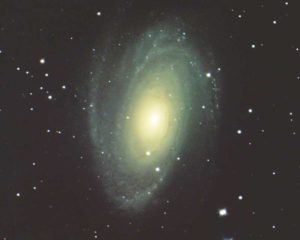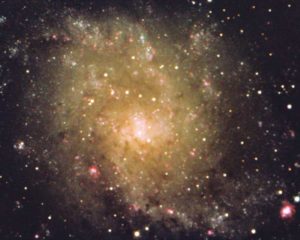M82. A starburst galaxy in Ursa Major.
M82 Is a galaxy about 12 million light years away where stars are being formed relatively rapidly. It is relatively near to M81 and the image on ethe right shows their relative positions. The two images taken to produce this composite had an area of overlap and the stars in that area were used to align the two images.
Settings
Date: 15-12-22
Camera Trius Pro 35
L 600s x 10 (1×1).
RGB 300s x 4 (2×2)
M81 Bode’s galaxy
A grand design spiral galaxy in Ursa Major.
Like M82, above, this is relatively near to our on Milky Way galaxy. Studies show that its nucleus has a supemassive back hole with a mass of 70,000,000 times the mass of the sun.
Settings
Date: 20-1-23
Camera Trius Pro 35
L 300s x 18 (1×1).
RGB 120s x 7 (2×2)
M74 The Phantom galaxy.
M74 is a large spiral galaxy in the constellation of Pisces.
M74 is about 32 million light years away. The image shown is cropped. The temperature was very cold and some artifacts got into the images. Fortunately the galaxy itself was unaffected. The surface brightness is low, which makes observation more difficult. As a result it is sometimes called the “phantom galaxy”.
Settings
Date: 15-12-22
Camera Trius Pro 35
L 600s x 10 (1×1).
RGB 300s x 4 (2×2)
IC342 The “Hidden” galaxy in Camelopardalis.
Settings Date 04-12-22. Camera Trius Pro 35. L 600s x 5 (1×1).RGB 120s x 3 (2×2)
In some cases, processing a faint galaxy can over-process the stars in the image. This is an example. It lies in the plane of the Milky Way and so there are many stars from our galaxy in the image. Also, the galaxy is partly obscured by dust prevalent in the Milky Way’s plane. The left image shows the original processed in the normal way. On the right are two images where the stars were first extracted using Star Xtractor and the galaxy and stars then processed separately. It is possible to control the brightness of the stars when they are replaced.
NGC 6946 Processed with Star Xtractor 12-12-22
This uses the data of 13-09-20 below, but using Star Xtractor the stars are first removed. This enables the galaxy and the stars to be processed separately. In this way the dominance of the stars can be controlled and more of the detail of the galaxy revealed.
M109
M109 is a pretty barred spiral galaxy in Ursa Major.
M109 is about 83 million light years away, so it has a small apparent size and a fairly low magnitude. It is the furthest galaxy in the Messier catalogue.
Settings
Date: 19-03-22
Camera SX694
L 600s x 5 (1×1). Time limited by state of sky. There was initial difficulty in finding a guide star. Something not encountered before.
NGC2903
NGC2903 is an isolated barred spiral galaxy in the constellation of Leo.
NGC2903 was originally mistaken for a nebula but resolved into a spiral form in the nineteenth century. It is inclined at an angle of about 60 degrees to our line of sight.
Settings
Date: 19-03-22
Camera SX694
L 600s x 8 (1×1). RGB 125s x 4 (2×2)
Sadly the computer crashed before the set number of subs had been collected.
M106
M106 is about 23 million light years away. It is one of the largest and brightest of nearby galaxies being similar in size and luminosity to the Andromeda galaxy. The central black hole has a mass of 40 million times the mass of the sun.
M106 has also helped in working cosmic distances. It contains Cephid variables similar to those in our Milky Way.
Settings
Date: 14-03-22
Camera SX694
L 600s x 5 (1×1) plus 300 x 15 (1×1) RGB 120s x 5 (2×2)
Taken with a fair amount of moonlight.
NGC891
NGC 891 (also known Silver Sliver Galaxy) is an edge-on unbarred spiral galaxy about 30 million light-years away in the constellation Andromeda. It was discovered by William Herschel on October 6, 1784. The galaxy is a member of the NGC 1023 group of galaxies in the Local Supercluster.
NGC 891 looks as the Milky Way would look like when viewed edge-on. This image is a retake of the one farther below using a camera with a smaller field of view.
Settings
Date: 27-02-22
Camera SX694
L 600s x 13 (1×1). RGB 120s x 7 (2×2)
A wide image view of this galaxy is seen below 08-02-21
NGC891
This is a wide field view of the galaxy. The field contains over 1,500 starts from our own galaxy. In the gallery, with the image seen larger, a number of other more distant galaxies are visible. Most notably another seen edge-on near the top of the image just right of centre.
Settings
Date: 08-02-21
Camera Trius Pro35
L 900s x 7 (1×1). RGB 300s x 4 (1×1)
NGC6946 Fireworks Galaxy
NGC 6946 (also known as the Fireworks Galaxy) is a face-on intermediate spiral galaxy with a small bright nucleus, whose location in the sky straddles the boundary between the northern constellations of Cepheus and Cygnus.
It is 40,000 light years across its distance from Earth is about 25.2 million light-years similar to the distance of M101 in the constellation Ursa Major. Both were once considered to be part of the Local Group but are now known to be among the dozen bright spiral galaxies near the Milky Way Galaxy but beyond the confines of the Local Group. NGC 6946 lies within the Virgo Supercluster.
Settings
Date: 13-09-20
Camera SX H694
L 900s x 3 (1×1). RGB 600s x 1 (1×1)
NGC 7331
NGC 7331 also known as Caldwell 30, is an unbarred spiral galaxy about 40 million light-years away in the constellation Pegasus.
There are a number of more distant galaxies visible to the left of NGC7331 – and one top right – that therefore look much smaller. The line across the image is probably a plane or possible a meteor.
Settings
Date: 02-09-20
Camera: SX H694
L 1200s x 5 (1×1). RGB 600s x 1 (2×2)
NGC4298 & NGC4302
NGC4298 is the upper galaxy and NGC4302 is the lower one which is seen edge on.
The two galaxies are at a similar distance of 53 million light years and there is evidence of an interaction between the two. Images with larger scopes confirm this as there is an asymmetrical distribution of stars in NGC4298.
Settings
Date: 25-04-20
Camera: SX H694
L 900s x 4 (2×2). RGB 400s x 1 (2×2)
M100
This galaxy is similar in shape to M101 but is much further away at about 55 million light years. It has a diameter of 107,000 light years. Its magnitude is 9.5 and so is much fainter that M101 which has a magnitude of 7.9.
In the image you can also see two much smaller galaxies – one centrally about one quarter of the way down the image. The other to the right (and up a bit) of M100. It is not unusual to see small distant galaxies in images such as these.
Settings
Date: 15-04-20
Camera: SX H694
L 1200s x 3 (1×1). RGB 900s x 2 (1×1)
M95
Messier 95, is a barred spiral galaxy located about 33 million light-years away in the zodiac constellation Leo.
The central bar is very clear. Galactic bars develop when stellar orbits in a spiral galaxy become unstable and deviate from an approximate circular path. The tiny elongations in the stars’ orbits grow and get locked into place, forming a bar. The bar becomes even more pronounced as it collects more and more stars in elliptical orbits. Eventually, a high fraction of the stars in the galaxy’s inner region join the bar. This process has been demonstrated repeatedly with computer-based simulations.
Settings
Date: 26-03-20
Camera SX H694
L 1200s x 2 (2×2). RGB 900s x 1 (2×2))
M101 Pinwheel Galaxy
The Pinwheel Galaxy , M101, is a face-on spiral galaxy distanced 21 million light-years away from Earth in the constellation Ursa Major.
The galaxy takes its name from the Catherine wheel (pinwheel) appearance. M101 is a large galaxy, with a diameter of 170,000 light-years. By comparison, the Milky Way has a diameter of 100,000[11] light-years. It has around a trillion stars, twice the number in the Milky Way. It has a disk mass on the order of 100 billion solar masses, along with a small central bulge of about 3 billion solar masses.
Settings
Date: 20-03-20
Camera SX H694
L 600s x 6 (2×2). RGB 600s x 2 (2×2)
NGC2841
NGC 2841 is an unbarred spiral galaxy in the northern circumpolar constellation of Ursa Major. It was discovered on 9 March 1788 by German-born astronomer William Herschel.
A 2001 Hubble Space Telescope survey of the galaxy’s Cepheid variables determined its distance to be approximately 46 million light-years.
This is the prototype for the flocculent spiral galaxy, a type of spiral galaxy whose arms are patchy and discontinuous. It is a spiral galaxy with no central bar and very tightly-wound arms. There is no grand design structure visible in the optical band, although some inner spiral arms can be seen in the near infrared. It is inclined by an angle of 68° to the line of sight from the Earth.
Settings
Date: 27-02-20
Camera SX H694
L 1200s x 3 (1×1). RGB 900s x 1 (1×1)
M51 Whirlpool Galaxy
The Whirlpool Galaxy, M51a, is a grand-design spiral galaxy interacting with a another galaxy NGC 5194. It lies in the constellation Canes Venatici.
It was the first galaxy to be classified as a spiral galaxy. Its distance is estimated to be 23 million light-years away from Earth. NGC 5195 (also known as Messier 51b) is a dwarf galaxy that is interacting with the Whirlpool Galaxy. Together, the two galaxies are one of the most widely studied interacting galaxy pairs.
Settings
Date: 20-02-20
Camera SX H694
L 600s x 6 (2×2). RGB 600s x 2 (2×2)
M81
Messier 81 is a grand design spiral galaxy about 12 million light-years away, with a diameter of 90,000 light years, in the constellation Ursa Major.
M81 has a 70 million solar mass supermassive black hole near the centre. The Hubble space telescope found globular clusters and regions of fluorescent gas.
Settings
Date: 28-01-20
Camera SX H694
L 600s x 5 (1×1). RGB 300s x 1 (1×1)
M33 Triangulum Galaxy
The Triangulum Galaxy is a spiral galaxy 2.73 million light-years (from Earth in the constellation Triangulum. It is catalogued as Messier 33.
The Triangulum Galaxy is the third-largest member of the Local Group of galaxies, behind the Milky Way and the Andromeda Galaxy. It has just 40 billion stars. In very dark skies it can just be made out with the naked eye. It is thought to be the most distant object so visible.
Settings
Date: 20-01-20
Camera SX H694
L 300s x 4 (1×1). RGB 300s x 1 (1×1)
